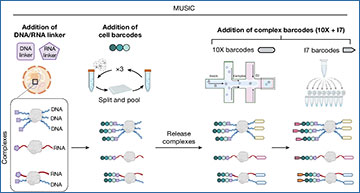Chromatin, the complex of DNA and proteins, plays a central role in orchestrating gene expression and cellular identity. However, the dynamic organization of chromatin complexes and their interplay with gene expression and RNA interactions remain a fascinating mystery. In a groundbreaking study, researchers at the University of California San Diego have introduced a revolutionary technique called multinucleic acid interaction mapping in single cells (MUSIC), offering a glimpse into the complex symphony of chromatin architecture and transcription within individual nuclei.
Exploring Chromatin Complexity
Chromatin is not static; it undergoes dynamic changes in composition and organization during cellular differentiation and ageing. Moreover, the heterogeneity of chromatin complexes among terminally differentiated cells adds another layer of complexity to cellular function. The MUSIC technique allows researchers to simultaneously profile multiplex chromatin interactions, gene expression, and RNA-chromatin associations within individual nuclei, providing unprecedented insights into cellular diversity and function.
MUSIC workflow and statistics
a, Schematic view of MUSIC experimental pipeline. b–d, Summary of MUSIC data in H1 cells. Numbers of uniquely mapped non-duplicate reads (b), clusters (c) and pairwise contacts (d) in every H1 cell (column, n = 2,546). DNA–DNA (DD, blue), RNA–DNA (RD, grey) and RNA–RNA (RR, yellow) clusters are counted separately. Multiplex interactions are projected to pairwise interactions, with the numbers of pairwise contacts shown in d.
Insights from Human Cortex Samples
To demonstrate the power of MUSIC, researchers applied this technique to 14 human frontal cortex samples from older donors. By analyzing chromatin interactions and gene expression patterns at the single-cell level, they were able to delineate diverse cortical cell types and states. Interestingly, they observed that nuclei with fewer short-range chromatin interactions were associated with both an ‘older’ transcriptomic signature and Alzheimer’s disease pathology, highlighting the potential relevance of chromatin organization in neurodegenerative disorders.
Unraveling Cellular Complexity
Furthermore, MUSIC revealed intriguing insights into the relationship between chromatin structure and gene expression regulation. For instance, the presence of chromatin contacts between cis expression quantitative trait loci and a promoter was indicative of specific gene expression patterns within certain cell types. Moreover, the study uncovered the highly heterogeneous interactions between the XIST non-coding RNA and chromosome X in female cortical cells, shedding light on the spatial organization of the X chromosomes.
The MUSIC technique represents a powerful tool for unraveling the intricate landscape of chromatin architecture and transcriptional regulation at single-cell resolution in complex tissues. By deciphering the symphony of chromatin dynamics within individual nuclei, researchers can gain deeper insights into cellular diversity, development, and disease pathogenesis. As this groundbreaking technology continues to evolve, it holds great promise for unlocking new discoveries in the field of biology and medicine, ultimately leading to improved diagnostics and therapeutic interventions for various diseases.
Availability – http://sysbiocomp.ucsd.edu/public/wenxingzhao/MUSIC_docker/intro.html
Wen X, Luo Z, Zhao W, Calandrelli R, Nguyen TC, Wan X, Charles Richard JL, Zhong S. (2024) Single-cell multiplex chromatin and RNA interactions in ageing human brain. Nature [Epub ahead of print]. [article]





